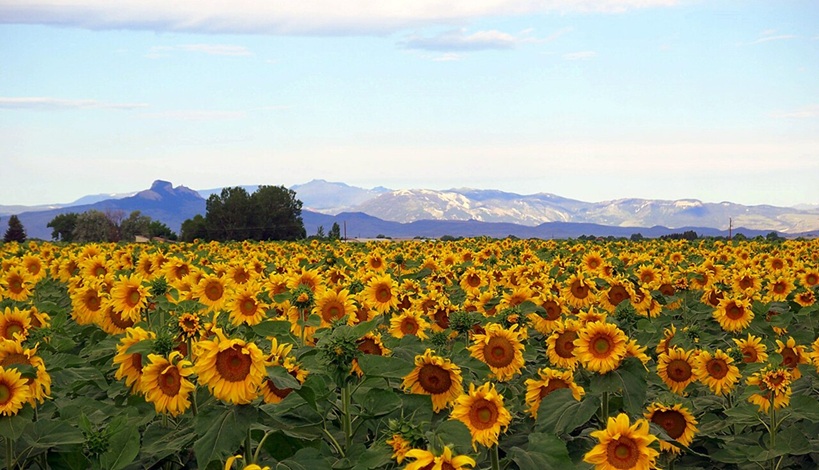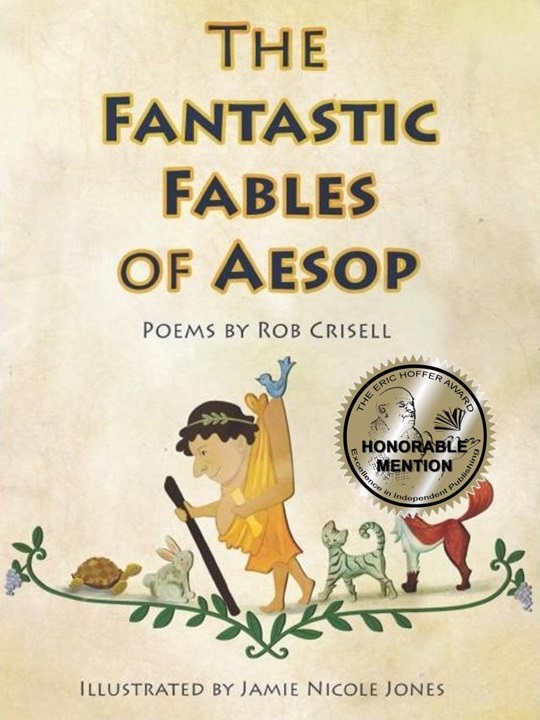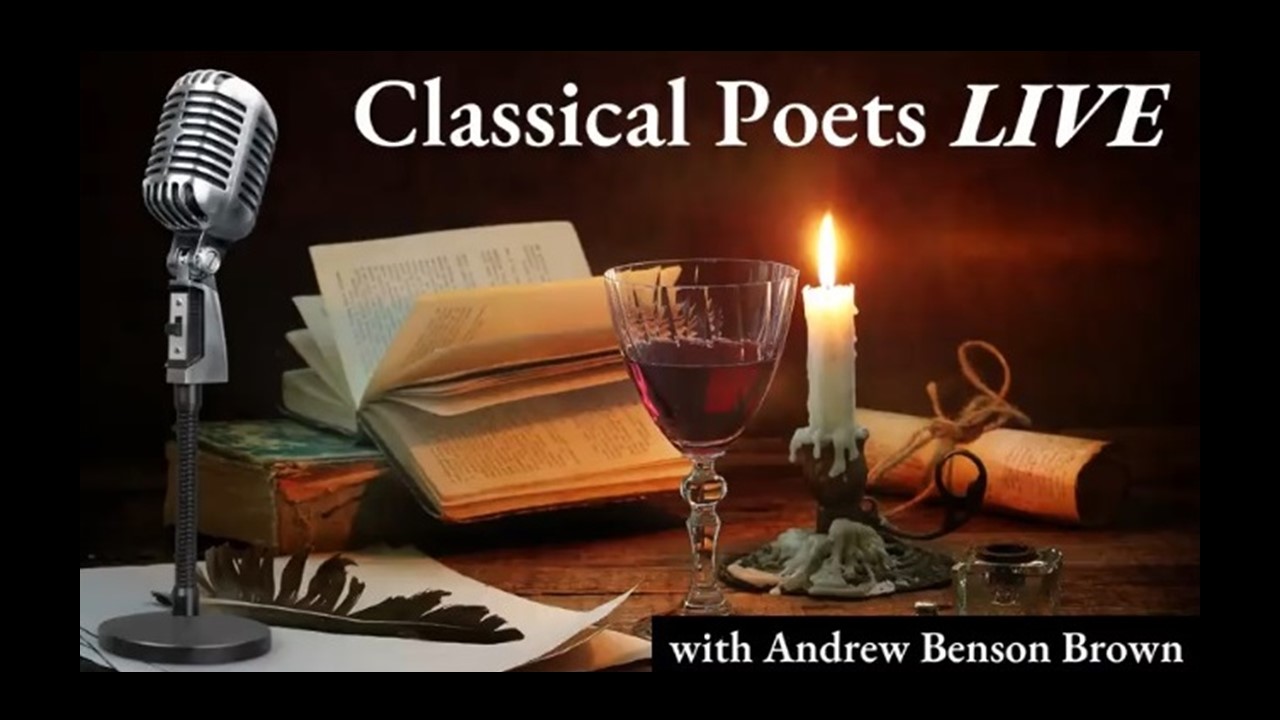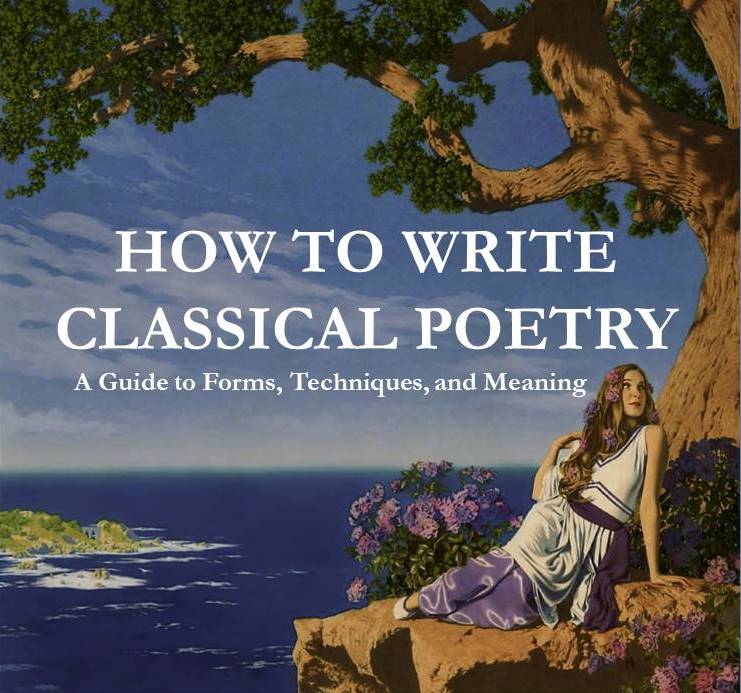.
Sunflower Field
_A boundless, isle-less sea of green
Bestrewn with yellow starbursts gently swaying—
The heavens mirrored, dazzlingly displayed
_Upon a rolling sea of jade
Where swells and ripples ceaselessly are playing
_Upon the fixed supernal scene.
A choir of yellow haloes blazing bright
With light drawn whence they turn in adoration,
Intently following: the coursing Sun
_Drenching them in his rays. To none
But him they deign raise eyes in supplication,
_Their warmth, their life-source, their one light.
_Rustling softly, they gently sway
In Zephyr’s warm, caressing breaths. Their beauty
The all-encircling peace of innocence
_Knowing no guile, no vain pretense,
Nor passions, lusts, nor envy; their one duty—
To face the Sun—they happily obey.
I long, trapped in this realm of woes and strife,
To reach that tranquil field of blooming sunflowers,
Infinity of starry souls, pure, free,
_Beyond desire, content to be
Nowhere else, where their joy lies far beyond ours,
Receiving Light, resplendent in its Life.
.
.
Adam Sedia (b. 1984) lives in his native Northwest Indiana and practices law as a civil and appellate litigator. He has published four books of poetry and his poems, essays, and fiction have appeared in various literary journals. He is also a composer, and his musical works may be heard on his YouTube channel.















Adam, this is such a beautiful poem that movingly describes a sunflower field with an innocent portrayal and great sensitivity to light as I have seen in Kansas and then transitions so smoothly to the supernal sunlight that the soul seeks. The creative imagery is superb. This one is heartfelt and a keeper.
Thank you! I know Kansas is the Sunflower State, but I received the inspiration for this poem on a train ride in Spain 22 years ago. The field in full bloom stretching far into the distance was an inspiring sight. I let my draft sit for nearly 20 years and finally revisited and reworked it, but the main idea of the original poem is still there.
A very interesting rhyme scheme (ABCCBA), with heterometric rhythms.
Heliotropic flowers do suggest obedience, along with deep peace, and an escape from life’s troubles. Strange that one of the myths concerning them (Helios and Leucothoe) is rooted in a tale of murder and thwarted love.
Varying interpretations of natural symbols (or really any symbol) is always fascinating. I believe Oscar Wilde adopted the sunflower as a symbol for the aesthetic movement based on its heliotropism. I followed suit, except with a more religious bent.
Adam, this poem’s visceral beauty is haunting to me. I also picked up on your instinctive use of monosyllabic words– out of curiosity I entered them into Chat GPT and I found the following:
Anglo-Saxon (Old English)
sea, green, bright, light, sun, rays, none, raise, eyes, warmth, life, sway, warm, breaths, gusts, long, woes, strife, reach, souls, free, be, far, ours
Not Anglo-Saxon (Romance origin)
jade, choir, scene, deign, guile, pure, joy
Borderline / Evolved Usage
swells, drawn, lusts, rays
Of these 36 monosyllabic words that you used, 25 were of Anglo-Saxon origin, 8 were of Romance origin, and 3 were of Old English/Norse roots with Romance influence. I have found that it is these monosyllabic words that reach deep into our language’s core– they are, to me, what makes English poetry (or any English writing) powerful and resonant. It is this Anglo-Saxon substrata that touches something ancient, elemental, primordial in the English language. You captured this essence in your poem! Fine work!
Thank you! I am impressed with the depth of your analysis. Gerard Manley Hopkins (and I another I can’t remember) preferred words with Anglo-Saxon origin for exactly the qualities you identify. I can’t say I made a conscious choice to gravitate to those words, but my unconscious decision was I think motivated by those same aesthetic qualities. Also, monosyllables allow for a greater range of expression within the strictures of meter. The SCP ran an essay I wrote about the virtues of monosyllables in poetry.
This is a gorgeous poem describing the grace and elegance of the field of flowers. I love the way it starts out comparing the sunflowers to the sea; not only do they roll and ripple like water, but they also mirror the heavens, as the sea reflects the sky and sun. And I definitely identify with the longing evoked in the final verse.
Thank you! I love to see a reader pick up on exactly the sensations I wished to convey.
My gosh, Adam, this is a spectacularly beautiful poem with a central metaphor of a sunflower field as Heaven. The blend of floral and religious imagery is as seamless as it is inspired and the overall effect is actually ethereal. It reads like a perfect Romantic poem. You could have convinced me that this was Wordsworth. I love this poem. So much.
The rhyme scheme and its reverse symmetry creates something of a poetic circle which both fits the flower imagery and offers a sense of the cyclic nature of life and death. Your choice of form was very sensitive.
And for some reason the quiet sense of joy and resolute hope that this poem gives me makes me think of the film Field of Dreams. “Is this Heaven?” “No, it’s Iowa.”
Thank you for the high praise. Romanticism was an important aesthetic influence on my in my younger days — when I first drafted this poem in 2003. I often hear my poetry compared to Wordsworth and it’s always flattering to hear, even though I was never consciously influenced by his works. He is a poet I have slowly grown to appreciate over the years, unlike Milton, whose genius struck me immediately.
Adam, for me, this poem (I love the form) with its mellifluous flow and excellent employment of silken sibilance, is hypnotic in its beauty. This lovely line is a prime example: “Rustling softly, they gently sway / In Zephyr’s warm, caressing breaths.” You have breathed life into a host of golden sunflowers to the point that I am standing amid your floral marvels, basking in their heavenly glory. For that, I thank you wholeheartedly!
Thank you! Your comment is a poem in itself. I am humbled and satisfied that my words could carry you to a place of such beauty.
I once wrote a horror story about boundless fields of sunflowers (derivative perhaps of Stephen King’s ‘Children of the Corn’) which conveyed both a sinister and scary. Your poem conveys exactly the opposite, Adam.
The final stanza shows how much we have to learn from sunflowers. A lesson in ‘sunflowerology’.
Thanks for the read.
Thank you! The possibilities for metaphor are endless, and I’m happy I could convincingly convey to you an impression entirely opposite from what you saw in your story. (Do you have a link? I would like to read it.)
As it happens, the sunflower is one of only four native North American plants with significant economic importance. The others are: blueberry, cranberry & pecan. What I have learned from Helianthus is that birds love their seeds more than they love almost anything else. A hundred million songbirds can’t be wrong. I am reminded that Jesus is the Christian manifestation of the archetypal Sun God.
Exactly! That association features as a subtext in the final stanza. I’m often reminded of Matthias Grunewald’s famous altarpiece showing the Resurrection, with Christ clearly depicted as a solar deity.
Adam — This poem is a treasure — the many lovely lines, the central metaphor, the haunting rhyme scheme. It’s masterful!
Thank you very much for the compliments! I tried to capture something of what I felt when I saw that scene.
Adam, this is an extremely rich poem. Not a flower poem per se (though it can qualify there too) but a landscape poem that very quickly asks for interpretation of the scene and its characteristics. You provide an analytical description in the final line of the first stanza: “fixed supernal field.” Each word here goes on to expand the naturally religious meaning of the work, which becomes clearer and more layered as you proceed. You play upon all the related symbolisms of the flower, and of the colors of the field. In my “language of flowers” references, the sunflower or heliotrope is adoration or devotion, in perfect accord with your explicitly religious allusions. You add the quality of obedience, the practical moral virtue by which heaven must be earned. I’ll notice that obedience has a place among religious vows in all Christian traditions, most explicitly in the Benedictine, where obedience is the principal vow and stability the unusual one. Sunflowers naturally possess that too, and manifest it by meaningful motion in place. The colors green and gold refer to growth of the earth and the light of the sun, both made their own by your blooms whose petals reflect and point to the sun. The human speaker in the final stanza contributes to what has already been said in third-person omniscient description. An array of inspired and inspirational eloquence throughout!
Thank you! You have delved deep into the poem and drawn out exactly what I felt when writing it. I saw in the sunflower field an earthly reflection of the sun itself, much as man is imprinted with the image of his Creator, and in its submission to the heavens a model worth praising.